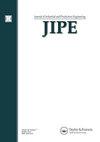Development of a body of knowledge for design for disassembly and recycling of high-tech products: a case study on lithium-ion batteries
IF 4.6
Q2 ENGINEERING, INDUSTRIAL
Journal of Industrial and Production Engineering
Pub Date : 2023-10-09
DOI:10.1080/21681015.2023.2262467
引用次数: 0
Abstract
ABSTRACTDemand for electronic products is growing, as is the volume of waste electrical and electronic equipment (WEEE). To reduce their environmental impact, particularly during their end-of-life, it is important to apply eco-design practices such as design for disassembly (DFD) and design for recycling (DFR) from the beginning of their development. However, these strategies are not systematically implemented by manufacturers due to several challenges, such as the complexity of the methods, the uncertainty and variability of the materials and components, and the lack of knowledge on DFD and DFR. This study aims to develop a body of knowledge (BOK) for DFD and DFR of electronic products to fill this gap. A systematic comparison of different BOKs has led to the proposal of a BOK composed of four main parts: Areas of Knowledge, Tools and Techniques, Skills and Abilities, and Terminology. The proposed framework was applied to lithium-ion batteries (LIBs) as an example of electronic products that require high-tech solutions for their efficient and sustainable management. This approach is essential for high-tech products, as they often contain valuable and scarce materials that need to be recovered and reused in a circular economy. The results showed that the BOK was an effective tool in supporting the sustainable development of batteries.KEYWORDS: Body of knowledgedesign for disassemblydesign for recyclinghigh-tech productslithium-ion batteries Disclosure statementNo potential conflict of interest was reported by the author(s).Acronyms BOK=Body of KnowledgeCAD=Computer-Aided designDFD=Design for DisassemblyDFR=Design for RecyclingEEE=Electrical and Electronic EquipmentEoL=End of LifeEV=Electric VehicleLCA=Life Cycle AssessmentLCC=Life Cycle CostLIB=Lithium-Ion BatteryPLM=Product Lifecycle ManagementTEA=Techno-Economic AssessmentWEEE=Waste Electrical and Electronic EquipmentAdditional informationFundingThe authors gratefully acknowledge the financial support from the Natural Sciences and Engineering Research Council of Canada (NSERC) for this research project. FundingThe authors gratefully acknowledge the financial support from the Natural Sciences and Engineering Research Council of Canada (NSERC) for this research project [grant number RGPIN-2020-05565].Notes on contributorsShady El JalboutShady El Jalbout is an engineer and a business developer with a background in mechanical and industrial engineering. He holds a bachelor’s degree in mechanical engineering and two master’s degrees, one in mechanical engineering and another in industrial engineering. He recently graduated from the professional master’s program in industrial engineering at Polytechnique Montreal. He currently works in the business development of high-tech and innovative products. His research interests include technology management, sustainability, high-tech product development and business models.Samira KeivanpourSamira Keivanpour is an assistant professor in the Department of Mathematical and Industrial Engineering at Polytechnique Montréal, Canada. She conducts research on sustainable solutions for supply chain and logistics management, with a focus on end-of-life product treatment, circular manufacturing, and the integration of Industry 4.0 technologies.高科技产品拆卸和回收设计知识体系的发展:锂离子电池案例研究
摘要电子产品的需求日益增长,废弃电子电气设备(WEEE)的数量也在不断增加。为了减少它们对环境的影响,特别是在它们的生命周期结束时,从它们的开发开始就应用生态设计实践,如拆卸设计(DFD)和回收设计(DFR),这一点很重要。然而,由于一些挑战,例如方法的复杂性,材料和组件的不确定性和可变性,以及缺乏对DFD和DFR的了解,制造商并没有系统地实施这些策略。本研究旨在建立电子产品DFD和DFR的知识体系(BOK),以填补这一空白。通过对不同教材的系统比较,我们提出了由四个主要部分组成的教材:知识领域、工具和技术、技能和能力以及术语。该框架被应用于锂离子电池(LIBs),作为电子产品的一个例子,需要高科技解决方案来实现其高效和可持续的管理。这种方法对于高科技产品至关重要,因为它们通常包含有价值和稀缺的材料,需要在循环经济中回收和再利用。结果表明,BOK是支持电池可持续发展的有效工具。关键词:知识体系拆解设计高科技产品回收设计锂离子电池披露声明作者未报告潜在利益冲突。首字母缩略词BOK=知识体系ecad =计算机辅助设计dfd =拆解设计dfr =回收设计eee =电气和电子设备ol =生命周期结束ev =电动汽车elca =生命周期评估lcc =生命周期成本lib =锂离子电池plm =产品生命周期管理tea =技术经济评估weee =废弃电气和电子设备附加信息资金作者感谢来自自然科学与工程研究委员会的资金支持加拿大国家科学研究委员会(NSERC)资助本研究项目。作者感谢加拿大自然科学与工程研究委员会(NSERC)对本研究项目的财政支持[批准号:RGPIN-2020-05565]。作者简介shady El JalboutShady El Jalbout是一名工程师和业务开发人员,拥有机械和工业工程背景。他拥有机械工程学士学位和两个硕士学位,一个是机械工程学位,另一个是工业工程学位。他最近从蒙特利尔理工大学工业工程专业硕士课程毕业。他目前从事高科技和创新产品的业务开发。他的研究兴趣包括技术管理、可持续发展、高科技产品开发和商业模式。Samira Keivanpour是加拿大montracei理工大学数学与工业工程系的助理教授。她研究供应链和物流管理的可持续解决方案,重点关注报废产品处理、循环制造和工业4.0技术的集成。
本文章由计算机程序翻译,如有差异,请以英文原文为准。
求助全文
约1分钟内获得全文
求助全文
来源期刊

Journal of Industrial and Production Engineering
ENGINEERING, INDUSTRIAL-
CiteScore
7.50
自引率
6.70%
发文量
21
 求助内容:
求助内容: 应助结果提醒方式:
应助结果提醒方式:


